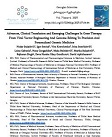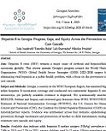ტეტრათიოდარიშხანმჟავას d10 - მეტალთა კომპლექსწარმოქმნის უნარი მონო- და ბიდენტატურ აზოტშემცველ ლიგანდებთან
ჩამოტვირთვები
სინთეზირებულია d10-მეტალთა ტეტრათიოარსენატების(V) კოორდინაციული ნაერთები მონოდენტატურ ლიგან-პირიდინთან, ზოგადი ფორმულით: [M(Py)4]3(AsS4)2 და ბიდენტატურ ლიგანდ - 2,2I-დიპირიდილთან, ზოგადი ფორმულით: ([M(dipy)2]3(AsS4)2), სადაც M=Cu(II), Zn(II), Cd(II). შემუშავებულია მათი სინთეზის ოპტიმალური პირობები. მიღებული კოორდინაციული ნაერთების შედგენილობა და აღნაგობა შესწავლილია ელემენტური, რენდგენოგრაფიული ანალიზისა და იწ სპექტროსკოპიული მეთოდებით. კვლევებით დადგინდა, რომ პირიდინი კომპლექსწარმომქმნელს უკავშირდება კოორდინაციული რიცხვის შესაბამისი ოდენობით, ხოლო 2,2I-დიპირიდილი ცენტრალურ იონთან ქმნის ხელატურ კომპლექსს.
Downloads
R.D. Gigauri. Synthesis and transformation organic compounds of arsenic on the basis As4O6. Diss., Dr. Chem. Sci., Tbilisi, 1988.
I. Didbaridze, G. Khelashvili, A. Chubinidze, R. Gigauri. Synthesis and Study of Tetrathio-arsenates of d10-metals.Bulletin of the Georgian Academy of Sciences, Tbilisi, 157, 1, 1998, 56-59.
I. Didbaridze, G. Khelashvili, M. Rusia, N. Endeladze, R. Gigauri. Sodium Tetra¬thio¬arsenate as a precipitate of ammoniate ions of Transitional Metals. Bulletin of the Georgian Academy of Sciences, 157, 2, 1998, 238-240.
Lekishvili, M. Rusia, L. Arabuli, Kh. Barbakadze, I. Didbaridze, M. Samkharadze. Arsenic and stibium advanced compounds with specific properties. ”Universali”, 2014.
Izolda Didbaridze, Tsivtsivadze Tengiz, Nestan Bregadze. THERMAL DECOMPOSITION OF TETRATHIOARSENATES OF TRANSITION METALS DURING HEATING 20-10000С. Proceedings of the XXIX International Scientific and Practical Conference International Trends in Science and Technology. https://conferences.rsglobal.pl/index.php/conf . 2021. 42-44
L. Belami. IR spectra of complex molecules. Leningrad, «Foreighn Liter.» ,1963, 591 p.
P.P. Shagidulin, I. Izosimovа. (As=S) in IR and KR Spectra. Izvestia of the Academy of Sciences of USSR. Chem. Ser., 1976, 5, , 863.
V.I. Mikheev, E.P. Saldau. Roentgenmetrical denerminant of minerals.Leningrad.«Недра» (in Rus.). 1965, vol. 2. 347 p.
G. Lipson, G. Stipl. Interpretation of Pouder Roentgenogrames. Moscow: “World” (in Rus.). 1972, v.2, 384 p.
Izolda Didbaridze, Nodar Lekishvili, Lagi Gvetadze, Nestan Bregadze. СOORDINATION COMPOUNDS OF SOME D-METALS OF TETRATHIOARSENATES(V) WITH ORTO-PHENYLENEDIAMINE. RS Global. World science. International Academy Journal. Web of Scholar. 1(19)Vol.2, January2018. pp 4-6. http://archive.ws-conference.com/web-of-scholar/wos2018/.
საავტორო უფლებები (c) 2024 ქართველი მეცნიერები

ეს ნამუშევარი ლიცენზირებულია Creative Commons Attribution-NonCommercial-NoDerivatives 4.0 საერთაშორისო ლიცენზიით .










































































































































































































